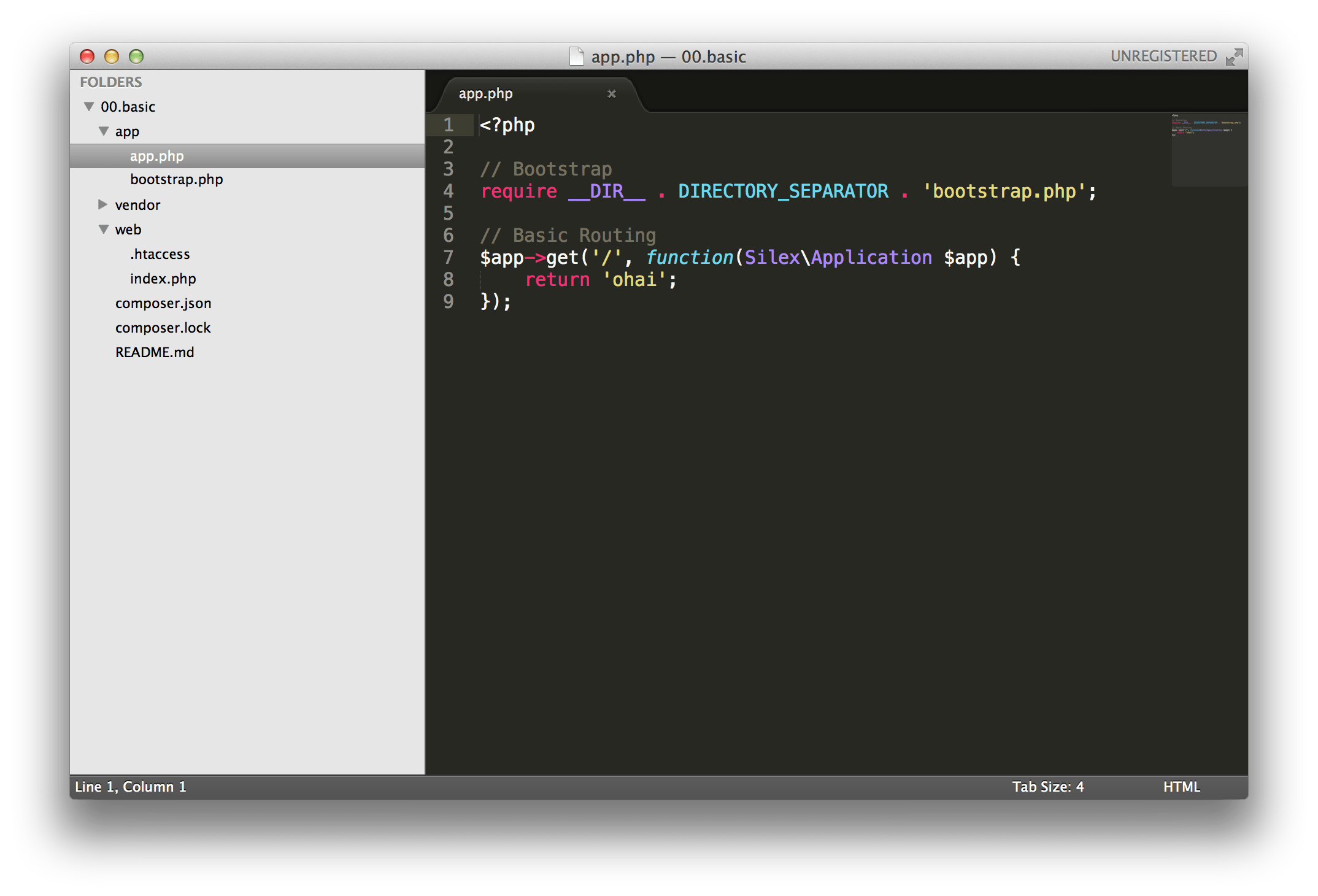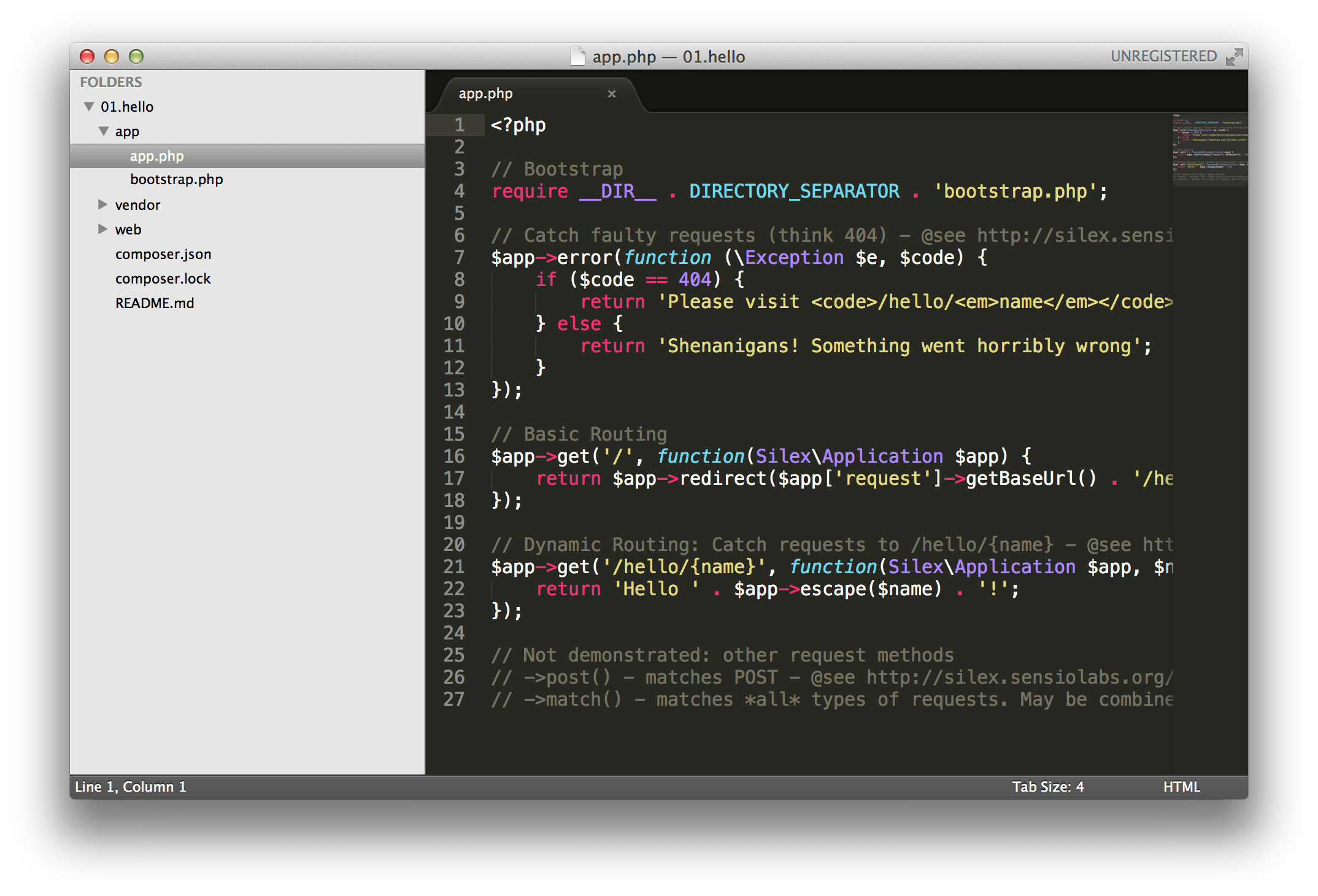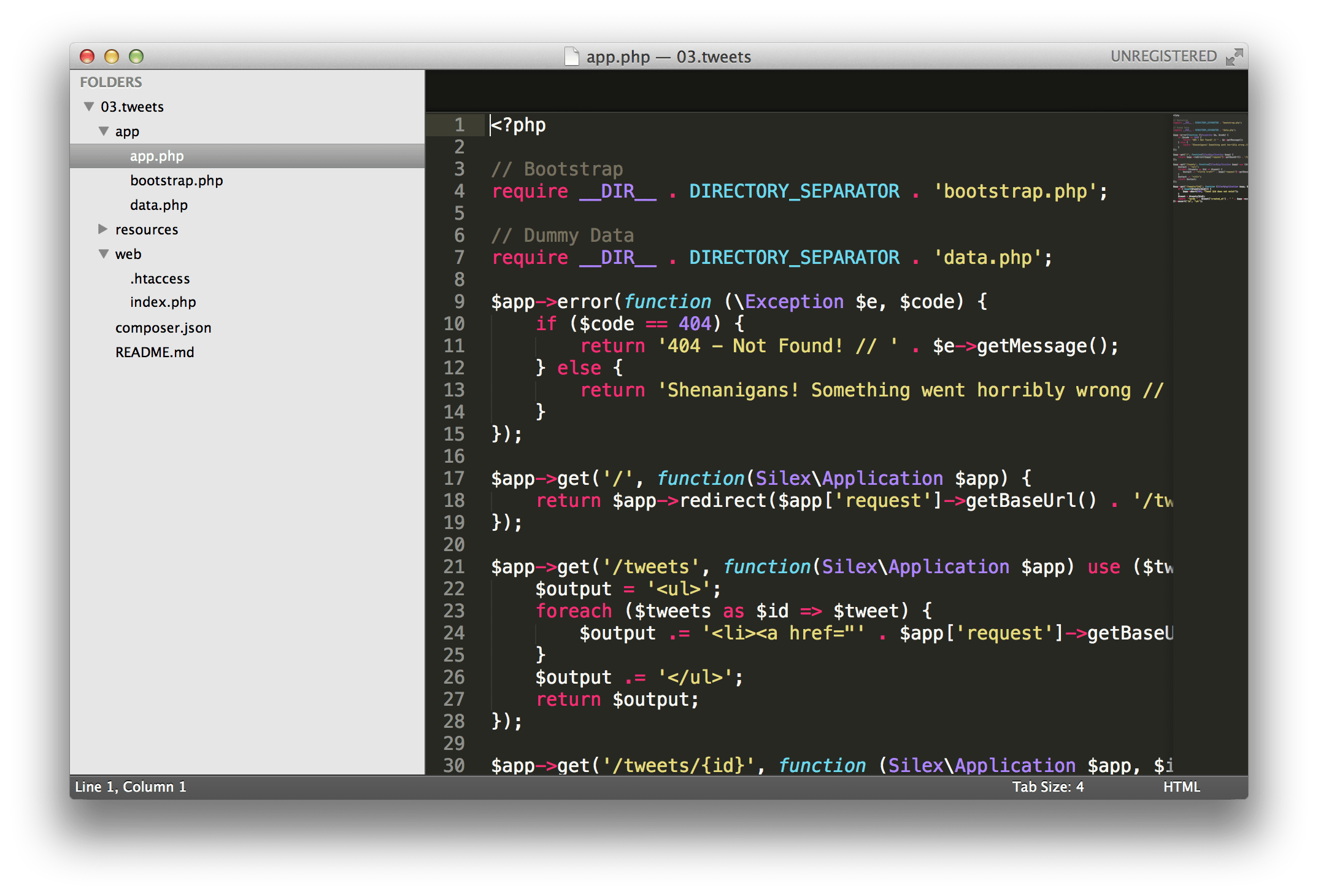Serverside Webscripting [JLW384]
03.silex.part1
It looks like you are viewing these slides on GitHub. Please clone the source repository in order to get the included PHP examples to work.
Silex Introduction

Silex
- PHP microframework
-
Built around routes
- When requesting
/show the homepage - When requesting
/newsshow all newsitems - When requesting
/news/{id}show the proper newsitem - When requesting
/news/{id}viaPOSTadd a comment - …
- When requesting
-
Extensible using Providers
- Twig Service Provider
- Doctrine Service Provider
- Swiftmailer Service Provider
- …
Installation
-
Installable via Composer
$ composer require silex/silex:~1.1
Code Example
-
The core of Silex is an instance of
Silex\Application- Register providers on it
- Define routes on it
require_once __DIR__ . '/../vendor/autoload.php';
$app = new Silex\Application();
$app->get('/hello/{name}', function($name) use($app) {
return 'Hello ' . $app->escape($name);
});
$app->run();Silex Internals
-
Internally, The Silex Core is built on top of
- Pimple, a Dependency Injection Container
- A few components of the Symfony Framework
Silex Boilerplate & Bootstrapping

If robots can't go to heaven, heaven can come to us.
Silex Boilerplate & Bootstrapping
-
Basic Silex Project Structure
-
public_html/— Public filesindex.php— Front Controllercss/&js/&img/&files/& ….htaccess(or the like)
-
app/— Project logicbootstrap.php— App Bootstrapapp.php— Routing
-
vendor/— (as created by Composer) -
composer.json&composer.lock
-
Example

Let's take a look at the files in assets/ws2-sws-fiddles-silex/00.basic/ →
Example Recap
-
/public_html/index.phpis the Front Controller<?php require_once __DIR__ . '/../app/app.php'; $app->run(); -
/app/app.phpcontains the actual routing<?php require __DIR__ . '/bootstrap.php'; $app->get('/', function(Silex\Application $app) { return 'ohai'; }); -
/app/bootstrap.phpcreates & configures the$app<?php require_once __DIR__ . '/../vendor/autoload.php'; $app = new Silex\Application(); $app['debug'] = true;
Silex Routing

Now here's a route with some chest hair.
Routing
-
Definitions⚑
- A route is a combination of a pattern and an HTTP method
- A route is handled by a handling function which returns/does x/y
-
In Silex⚑
$app->match('pattern', function(Silex\Application $app) { // ... })->method('GET|POST'); -
Shorthands (preferred)⚑
$app->get('pattern', function(Silex\Application $app) { // ... }); $app->post('pattern', function(Silex\Application $app) { // ... });
Static Routing
- Static routes are routes with a fixed pattern
$app->get('/', function(Silex\Application $app) { // show something (e.g. return a blob of HTML) }); $app->get('/about/', function(Silex\Application $app) { // show something else (e.g. return a blob of HTML) }); $app->post('/', function(Silex\Application $app) { // do something (e.g. insert into database, send e-mail) });
Dynamic Routing
-
Dynamic routes⚑ are routes with a dynamic pattern
- The dynamic parts of the pattern will be converted to route variables⚑ which you pass into the handling function
$app->get('/hello/{name}/', function(Silex\Application $app, $name) { return 'Hello ' . $app->escape($name) . '!'; });$app->get('/blog/{postId}/{commentId}/', function (Silex\Application $app, $postId, $commentId) { // ... });
Redirecting and Error Handling
-
Redirect using
$app->redirect()⚑$app->get('/', function(Silex\Application $app) { return $app->redirect($app['request']->getBaseUrl() . '/hello'); }); -
Override the default error handling using
$app->error()⚑$app->error(function (\Exception $e, $code) { if ($code == 404) { return 'Please visit <code>/hello/<em>name</em></code>'; } else { return 'Shenanigans! Something went horribly wrong'; } });
Important note on route patterns
-
Define your patterns with a trailing
/$app->get('/hello', …);will respond tohttp://localhost/hellobut not tohttp://localhost/hello/$app->get('/hello/', …);will respond tohttp://localhost/helloand tohttp://localhost/hello/
Example

Let's take a look at the files in assets/ws2-sws-fiddles-silex/01.hello/ →
Route Prerequisites
Example

Let's take a look at the files in assets/ws2-sws-fiddles-silex/02.olleh/ →
Route Prerequisites, Redux
-
Not covered in the example, but also possible:
-
Limit routes on a host using
->host()$app->match('/', function() { // app-specific action })->host('example.com'); $app->match('/', function ($user) { // user-specific action })->host('{user}.example.com'); -
Require HTTP/HTTPS using
->requireHttp()and->requireHttps() -
Convert variables to a certain type using
->convert()$app->get('/user/{id}', function ($id) { // ... })->convert('id', function ($id) { return new User($id); });
-
Limit routes on a host using
Sidenote: Request & Response (1)
-
As said, Silex uses Symfony Components internally
- The aforementioned
$app['request']actually is an instance ofSymfony\Component\HttpFoundation\Request⚑ - Next to
Request, Silex also uses Symfony'sResponse⚑
use Symfony\Component\HttpFoundation\Request; use Symfony\Component\HttpFoundation\Response; $app->post('/feedback', function(Request $request) { $message = $request->get('message'); mail('feedback@yoursite.com', '[YourSite] Feedback', $message); return new Response('Thank you for your feedback!', 201); }); - The aforementioned
Sidenote: Request & Response (2)
-
It's also possible to send other types of responses
-
JSON:
JsonResponseor use the$app->json()shorthand⚑$app->get('/users/{id}', function(Silex\Application $app, $id) { return $app->json(getUser($id)); }); -
Files:
BinaryFileResponseor use the$app->sendFile()shorthand⚑$app->get('/files/{path}', function(Silex\Application $app, $path) { if (!file_exists('/base/path/' . $path)) { return 'Invalid File'; } return $app->sendFile('/base/path/' . $path); });
-
JSON:
Structured Routing

Number 1.0, I hereby petition you
for an emergency sort-and-file!
Base Example

Let's take a look at the files in assets/ws2-sws-fiddles-silex/03.tweets/ →
Example Analysis (1)
-
Pass extra data to handling functions with
use⚑$app->get('/tweets', function(Silex\Application $app) use ($tweets) { $output = '<ul>'; foreach ($tweets as $tweet) { $output .= '<li><a href="' . $app['request']->getBaseUrl(). '/tweets/' . $app->escape($tweet['id']) . '">¶</a> ' . $app->escape($tweet['text']) . '</li>'; } $output .= '</ul>'; return $output; }); -
Trigger errors with
$app->abort()⚑$app->get('/tweets/{id}', function(Silex\Application $app, $id) use ($tweets) { if (!in_array($id, array_column($tweets, 'id'))) { $app->abort(404, "Tweet $id does not exist"); } ... })->assert('id', '\d+');
Example Analysis (2)
-
Codebase doesn't scale well
- What if we need to define more logic/routes?
→/app/app.phpwill quickly become one cluttered mess - Solution: Organize our routes in a ControllerCollection
- What if we need to define more logic/routes?
-
Building strings of HTML in your PHP is plain stupid
- Solution: introduce Twig or the like
Route Controllers (1)
-
Group routes in a
ControllerCollection⚑ -
Mount the
ControllerCollectioninstance onto a base route// define controller for a blog $blog = $app['controllers_factory']; $blog->get('/', function () { return 'Blog home page'; }); $blog->get('/{id}', function () { return 'Blog detail page'; })->assert('id', '\d+'); // Mount the blog controller onto the /blog route $app->mount('/blog', $blog);
Route Controllers (2)
-
Structure is still lacking with just
ControllerCollection -
We've talked about structure before
- … right?
- Right! Classes, and namespaces, and PSR-0!


Route Controllers (3)
-
Silex' structured answer: ControllerProviders⚑ in which you wrap a
ControllerCollection- If we namespace our own controllerproviders properly, we'll have a good structure
Revised Example

Let's take a look at the files in assets/ws2-sws-fiddles-silex/04.tweets-organized/ →
Example Recap (1)
-
Create a namespace of your own
-
Place your namespace in
/src -
Autoload your namespace by adjusting
composer.json{ "require": { "silex/silex": "~1.1" }, "autoload": { "psr-0": { "Ikdoeict": "src/" } } } -
Important: Run
composer updateif you've already runcomposer install
-
Place your namespace in
Example Recap (2)
-
Create a ControllerProvider per group of routes
-
The class must implement
Silex\ControllerProviderInterface -
Name of the class can be chosen freely, though something like
TweetsControllerrecommended -
Place the file in
/src/Namespace/Provider/Controller -
The
connectfunction regulates the (sub)routes to other instance functions
-
The class must implement
-
Mount your class on the subroute from
/app/app.php$app->mount('/tweets', new Ikdoeict\Provider\Controller\TweetsController());